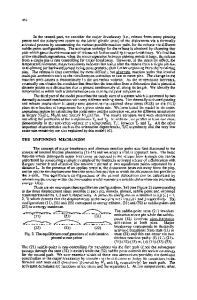Size Scaling in the Self-Immortalization of Superdislocations in the L1 2 Compounds Displaying the Yield Strength Anomal
- PDF / 358,901 Bytes
- 4 Pages / 414.9 x 643.14 pts Page_size
- 19 Downloads / 306 Views
analysis is sampled at some constant rate, and assigns a dislocation self-immobilization rate accordingly. Louchet then couples this analysis with a multiplication mechanism to develop a theory of the deformation of these compounds [8]. Louchet's theory, however, has one shortcoming. It does not account for the length dependence of the dislocation exhaustion rate. Simulations [3,9], as well as a simple argument, suggest that the dislocation exhaustion rate should depend on the length of the dislocation. First, it is noted that the number of superkinks along a dislocation should scale linearly with the dislocation length. Then, under the assumption that one draws each of these superkinks from the same superkink length distribution, the probability that one finds a very long superkink should increase with the number of superkinks drawn from the distribution. Hence, one expects that longer dislocations are more likely to be mobile and will have a lower self-immobilization rate. In the current contribution, Louchet's exhaustion rate is reconsidered. This reconsideration leads directly to an expression for the length dependence of the dislocation exhaustion rate. (An extension of this analysis is presented in reference [10].) STATISTICAL ANALYSIS Define w(A)dA to be the number of superkinks in the entire crystal with lengths between A and A + dA. Define A,to be the critical length for superkink mobility. Then the probability that a superkink is shorter than Ac is given by W(A,): W(2LJ= Jw(A)clA(1 0
It is assumed that if a dislocation contains at least one superkink longer than AC,the dislocation will be mobile. Hence, one needs to find the distribution governing the longest superkink along a dislocation. This distribution is constructed in the following manner. It is assumed that the global distribution of superkinks, w(A), is known. A dislocation containing n superkinks is constructed by drawing n superkinks from this global distribution. This procedure is guaranteed to yield the correct global superkink population, when one considers a large number of dislocations. This, however, is no guarantee that the individual dislocations are described properly. Effectively, the procedure ignores the possibility that the population of superkinks along a single dislocation may reflect the dynamics of superkink spawning, scattering and annihilation [3-5]. These dynamics may lead to correlations in the superkink length distributions along a single dislocation. The current formulation neglects these correlations, and must be considered to be a type of "mean-field" approximation. The probability that the longest of n superkinks falls between A and A + dA is given by:
P(k) A =n[W(A)f 1 w(A)dA
(2)
where the factor n accounts for the different permutations in the drawing order of the n superkinks. (Louchet's result agrees with the above for n = 2 [8].) As in Louchet's work, it is assumed that as the dislocation propagates, it samples the distribution of Eq. (2) at some constant rate. Physically, this sampling rate must exceed the ti
Data Loading...











